Editors: Piotr Wojtal, Jarosław Wilczyński (2019)nakład wyczerpany
3rd Conference World of Gravettian Hunters, Kraków, Poland, 20-24 May 2019
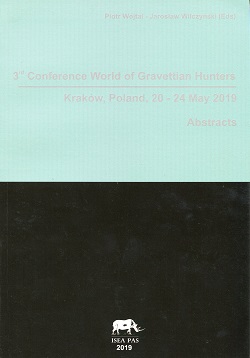
75 pp., paperback, ISBN 978-83-61358-92-3
Book of abstracts 3rd Conference “World of Gravettian Hunters”. The conference was held from 20 to 24 May 2019 in Kraków, Poland. The meeting was organized by the Institute of Systematics and Evolution of Animals of the Polish Academy of Sciences, in cooperation with Polish Academy of Arts and Sciences. In all, 88 scientists participated, representing 56 scientific institutions in Europe and North America. During nine sessions, 48 lectures and 16 posters were presented of different branches of archaeology, palaeontology, zooarchaeology, geology, and other disciplines.
Ewa Przyboś, Sebastian Tarcz (2018)
Paramecium (Protista, Ciliophora, Oligohymenophorea) as a model organism in biological studies, especially concerning speciation process
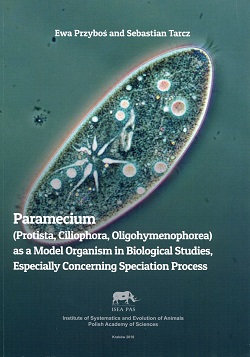
68 pp., paperback, ISBN 978-83-61358-80-0
This is a consize monography of genus Paramecium, the authors provide information about its particular subgenera, and, in turn, their species (e.g. cytological characteristics, and phylograms are included). The largest chapter concerns subgenus Paramecium, and the P. aurelia species complex. Paramecium is a very suitable object for studies of protist microevolution with application of genetic, cytological, and molecular techniques, as is composed of several morphological species, arranged into subgenera, species in turn consist of cryptic or sibling species. In fact, they are biological species, being reproductively isolated groups.
Editor: Jarosław WILCZYŃSKI (2015)
A Gravettian Site in Southern Poland - Jaksice II
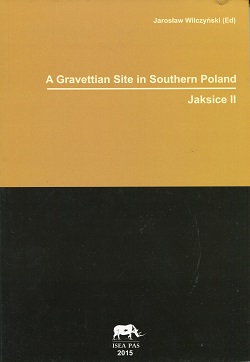
132 pp., paperback, ISBN 978-83-61358-68-8
In March 1912, west of the village Jaksice, on the bank of the Wisła River, opposite the mouth of the Raba River, L. Kozłowski and W. Kuźniar discovered an important Paleolithic site. A lens of mixed gray bone ash, bone fragments and single flint artefacts was discovered at a depth of about 6 meters below the ground surface in a loess exposure eroded by a local stream. In late autumn 2010, almost 100 years after the discovery by L. Kozłowski and W. Kuźniar, new work was undertaken at the presumed location in Jaksice. Current systematic excavations were carried out 2011-2014, covering an area of 39 sq m, and uncovering lithic artefacts, mammal remains (mainly reindeer and mammoth), as well as a few ivory tools and shell beads. The fieldwork has provided a most interesting Late Gravettian lithic inventory, quite different from what we know from the Kraków Spadzista site, and has led to new research on the diversity of Late Gravettian lithic inventories in Central Europe.
Editors: Piotr WOJTAL, Jarosław WILCZYŃSKI, Gary HAYNES (2015)
A Gravettian Site in Southern Poland - Kraków Spadzista
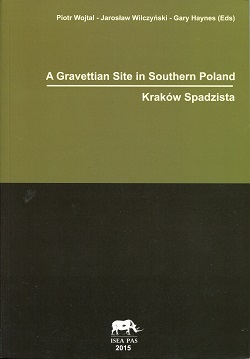
205 pp., paperback, ISBN 978-83-61358-72-5
The Kraków Spadzista site is one of the most important and recognisable sites of Gravettian settlement in Poland. Excavations began in 1967, and continued with several breaks until 2013, encompassing various parts of this vast site. Thanks to these excavations, plentiful traces have been discovered of an Upper Palaeolithic settlement, predominantly represented by Gravettian materials. The most recent fieldwork began in the summer of 2011 at the site, and initiated an exceptionally intensive research stage that has produced abundant archaeological and paleontological discoveries. Originally, this volume was intended to present the results of the 2012 research in the Kraków Spadzista E1 area. However, owing to the multitude of analyses conducted on the materials obtained during the most recent field research and the older excavations, as well as the fact that the representatives of various scientific disciplines were engaged in this work, the scope of this publication has been expanded considerably. Consequently, we have abandoned our previous practice of publishing our research results in the form of a concise monograph dedicated to a single part of a site. The collected texts form the present volume, which describes and interprets materials discovered during 50 years of archaeological research at one of the most important Upper Palaeolithic sites in Poland.
Krzysztof Stefaniak (2015)
Neogene and Quaternary Cervidae from Poland
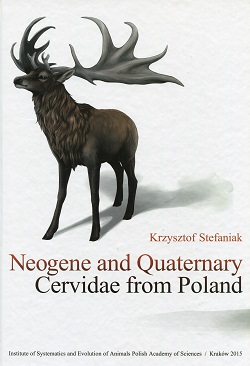
104 pp., hardback, ISBN 978-83-61358-64-0
The book is a result of long experience of Krzysztof Stefaniak with fossil cervids of Europe. It summarises the state of the art of the studies on the fossil cervids of Poland, starting with the Miocene through to the present, with an extensive reference to the faunas of the rest of Eurasia and the World. It deals with 16 species, based on more than 5500 remains from 72 localities. The book provides a perspective on the climate- and evolution-dictated changes in the cervid fauna of Eurasia. The book is illustrated with maps, morphometric graphs, diagrams of evolution of particular cervid taxa and coloured plates; most morphometric and stratigraphic data are shown in tables. With its detailed citation of all the sources and the new interpretation of the history of cervid assemblages presented in a broader context, it will certainly provide the Reader with a comprehensive up-to-date account of the European cervid fossil fauna.
Alina Krzemińska (2014)
Abnormalities and Other Changes on Wolly Mammoth Bones from Central Europe 32,000 to 20,000 years ago – a monograph
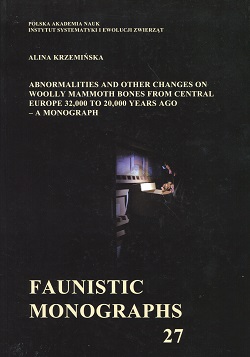
106 pp., hardback, ISBN 978-83-61358-60-2
Price: Europe 20 €
The monograph is a study of abnormalities and other changes on bone of woolly mammoths from Central Europe 32,000 to 20,000 years ago. The examination included mammoth bones from Kraków Spadzista (Poland), Milovice I, Dolní Vĕstonice I, and Předmostí (all three in the Czech Republic). The material studied amounts to over 100,0000 bones. The results are illustrated by 77 color plates comprising about 200 photographs. The bone changes fall into two main groups: ontogenetic and pathological & posttraumatic. The first group comprises unusually developed bones, asymmetry, and bone fusions, while the second group those which developed in response to injuries, infections, inflammmations, tumors, or metabolic disorders. Information from all previously published articles and relevant cases from literature are included.
Redakcja Elżbieta Warchałowska-Śliwa (2014)
Ćwierćwiecze Instytutu Systematyki i Ewolucji Zwierząt Polskiej Akademii Nauk w Krakowie. 150 lat tradycji badawczych i muzealnych
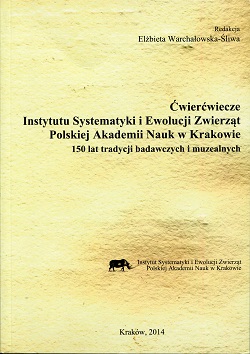
186 pp., paperback, ISBN 978-83-61358-56-5
W 2014 roku minęło 25 lat od utworzenia Instytutu Systematyki i Ewolucji Zwierząt PAN i 60 lat działalności naukowej placówki. Te rocznice stały się okazją do opisu historii i działalności Instytutu. W większości przypadków rozdziały omawiające poszczególne jednostki organizacyjne są pracą zbiorową zatrudnionych w nich pracowników oraz wysiłkowi wielu osób zaangażowanych przy zbieraniu danych i opracowaniu ogromnej ilości zdjęć. Wiele cennych informacji dotyczących nazwisk, dat i szczegółów odtworzono dzięki pamięci emerytów i pracowników-seniorów. Książka nie jest typowym opracowaniem ponieważ oprócz archiwalnych i suchych informacji zawiera wiele elementów subiektywnych. Kolejne rozdziały omawiają historię jednostki, poszczególnych zakładów i ich pracowników, osiągnięcia taksonomiczne i dane dotyczące publikacji. Całkiem inny charakter mają „Wspomnienia pracowników” oraz „Egzotyczne wyjazdy badawcze”, które są zbiorem luźnych opowiadań, często napisanych ze swadą i z przymrużeniem oka, lub nieco bardziej stonowane, które nadają duży koloryt niniejszej książce. Całość jest bogato ilustrowana a zamieszczone na osobnej płytce zdjęcia – od czarno-białych, poprzez przeźrocza i negatywy kolorowe aż po zdjęcia cyfrowe - ilustrują wiele cennych elementów z życia naszej jednostki zarówno oficjalnych jak i całkiem nieformalnych. Oddając do rąk czytelników niniejsze opracowanie mamy nadzieję, że w ten sposób nieomal w ostatniej chwili ratujemy dużą część historii polskiej nauki związanej z naszym Instytutem.
Editor: Piotr Wojtal (2013)
International Conference “World of Gravettian Hunters”, Kraków, Poland, 25th-28th June 2013
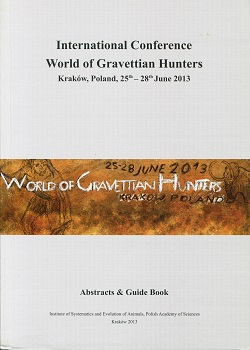
163 pp., paperback, ISBN 978-83-61358-52-7
Book of abstracts 1st Conference “World of Gravettian Hunters”. To celebrate the 45th anniversary of the first excavations at the Gravettian site Kraków Spadzista Street in Poland, a conference called “World of Gravettian Hunters” was held from 25 to 28 June 2013 in Kraków, Poland. The meeting was organized by the Institute of Systematics and Evolution of Animals of the Polish Academy of Sciences, in cooperation with the Department of Paleozoology of the University of Wrocław, the Institute of Archaeology of Jagiellonian University, the Archeological Museum in Kraków, and the “Upper Palaeolithic of the Western Eurasia” commission of the International Union of Prehistoric and Protohistoric Sciences (Union Internationale des Sciences Prèhistoriques et Protohistoriques - UISPP). In all, 73 scientists participated from Europe and North America. During eleven sessions, 43 lectures and 12 posters were presented of different branches of archaeology, palaeontology, zooarchaeology, geology, and other disciplines.
Zygmunt Bocheński, Zbigniew M. Bocheński, Teresa Tomek (2012)
A history of Polish birds.
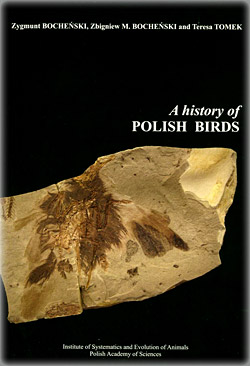
226 pp, hardback, ISBN 978-83-61358-44-2
Price: Europe 30 €
"A history of Polish birds" is the first book to summarize our knowledge of bird remains from all fossil and subfossil sites in Poland, compare it with books and papers on the fauna of Poland published since the 16th century, and contrast this with the recent status of each species. It should prove to be an invaluable resource for avian palaeontologists, zooarchaeologists and ornithologists, as well as serious birdwatchers who wish to broaden their knowledge. The book is more than just a catalogue or an encyclopedia. It includes entries on every species and summarizes their occurrence in Poland from the earliest fossil records to the present day. User-friendly additions such as stratigraphic charts, a graphical presentation of the temporal distribution of all avian taxa in Poland and a complete list of fossil and subfossil sites with bird remains make it easy to follow even for non-specialists. Numerous illustrations help the scientific content.
Krzysztof Solarz (2012)nakład wyczerpany
The House Dust Mites and Storage Mites (Acari: Oribatida: Astigmatina). Identification keys.
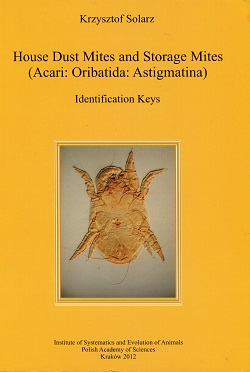
120 pp., paperback, ISBN 978-83-61358-48-0
Price: Europe 20 €
This book presents morphological characteristics of the most medically important taxa of mites, especially genera from the families Pyroglyphidae (Dermatophagoides, Sturnophagoides, Malayoglyphus, Hirstia, Euroglyphus, Gymnoglyphus), Acaridae (Acarus, Tyrophagus, Tyrolichus, Tyroborus, Aleuroglyphus, Thyreophagus, Caloglyphus, Rhizoglyphus), Glycyphagidae (Glycyphagus, Lepidoglyphus, Gohieria, Ctenoglyphus), Aëroglyphidae (Aëroglyphus) and Chortoglyphidae (Chortoglyphus). Most mite specimens were obtained from research collections in the United States, UK and Belgium, from house dust samples, bird nest and farming environments. Differential diagnoses of subfamilies, genera and species illustrated by photomicrographs and identification keys are presented. This book includes also distribution of the presented species of domestic mites. Diagnoses of clinical symptoms in allergic patients caused by domestic or storage mites are partially based on the identification of species, but this can be difficult because of the lack of user-friendly keys and the dispersed literature. This publication was begun in response to these hindrances and it is intended to help acarologists to identify the mites they may find associated with storage products, farming environments and house dust samples
Aleksandru Lungu and Barbara Rrzebik-Kowalska (2011)
Faunal assemblages, stratigraphy and taphonomy of the Late Miocene localities in the Republic of Moldova
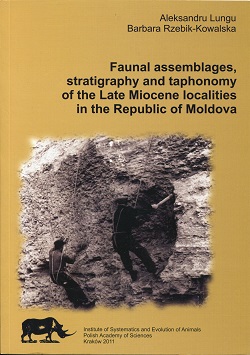
62 pp, paperback, ISBN 978-83-61358-40-4
Price: Europe 8 €
Praca pt. “Faunal assemblages, stratigraphy and taphonomy of the Late Miocene localities in the Republic of Moldova” autorstwa B. Rzebik-Kowalskiej i A. Lungu zawiera opis 33 stanowisk kopalnych położonych na terenie Republiki Mołdowy, datowanych na okres późnego miocenu (Astracianu – MN8, Vallesianu – MN9, MN10 i Turolianu – MN11- MN13). Te późnomioceńskie złoża reprezentują głównie środowiska pochodzenia morskiego, deltowego, rzecznego i jeziornego. Znaleziona w nich bogata “Hiparionowa“ fauna zawiera mięczaki, ryby, płazy, gady, ptaki i ssaki. Ssaki reprezentowane są przez ssaki owadożerne (Soricomorpha i Erinaceomorpha), nietoperze (Chiroptera), zajęczaki (Lagomorpha), gryzonie (Rodentia), nieparzystokopytne (Perissodactyla) parzystokopytne (Artiodactyla), trąbowce (Proboscidea), drapieżne (Carnivora), mrówniki (Tubulidentata), naczelne (Primates), syreny (Sirenia), płetwonogie (Pinnipedia) i walenie (Cetacea). W późnym miocenie Mołdowa znajdowała się w miejscu kontaktu prowincji paleobiogeograficznych, które miały wyraźny wpływ na kształt zespołów jej fauny. Badania prezentowane w pracy pomagają wyjaśnić niektóre aspekty ewolucji „Hiparionowej” fauny ssaków podczas późnego miocenu na terytorium wschodniej Paratetydy.
Zdzisława T. Stebnicka (2011)
Aegialiini and Eremazini of the World (Coleoptera: Scarabaeidae). Iconography
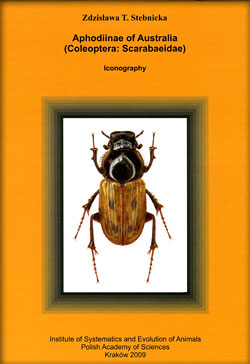
92 pp., hardback, ISBN 978-83-61358-36-7
Price: Europe 18 €
“Aegialiini and Eremazini of the World (Coleoptera: Scarabaeidae)” is the fourth and the last one book with iconography of scarab beetles (Coleoptera, Scarabeidae) by T.Z. Stebnicka, the eminent taxonomist of Scarabaeidae. The two tribes discussed herein include relictual and highly aberrant 11 genera with 73 species known at that time, inhabiting Nearctic, Palaearctic, Australian and Neotropical regions. The essential diagnoses of the genera and species with their synonyms, location of the name-bearing types, data on affinities, distributions and bionomics are associated with colour photographs of beetles and drawings of the pertinent morphological details. A testable hypothesis of relationships among genera and species is visualized on the phylogenetic trees, as well as documented fossils of extinct and extant species of the Aegialiini are listed and commented. The bibliography contains monographs, revisions and other descriptive publications dealing with taxonomy and biology of both tribes on the world basis.
Natalia Starzyk, Ewa Krzemińska (2011)
Trylobity.
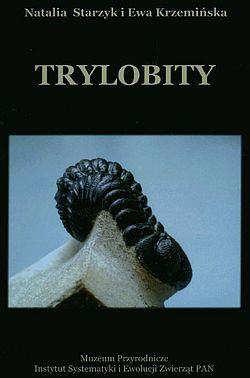
Grzegorz Paśnik (2010)
Phylogeny and generic classification of Tachyusini (Coleoptera, Staphylinidae: Aleocharinae)
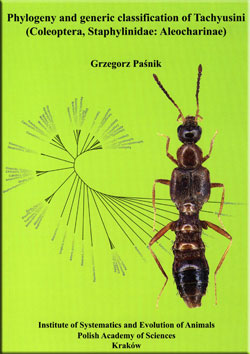
129 pp, paperback, ISBN 978-83-61358-28-2
Price: Europe 20 €
The monograph presents a comprehensive study of the tribe Tachyusini. The book consists of three major parts: - introductory part that provides an overview of the classification of the genera and a nomenclatural history of the tribe Tachyusini. - phylogenetic part that presents results of the cladistic analysis, which was reconstructed based on morphological data, using maximum parsimony and Bayesian inference analyses. The results of the performed analyses strongly support the monophyly of the Tachyusini on the base of five unambiguous synapomorphies. In the maximum parsimony analysis, the tribe Oxypodini is resolved as sister group to the ingroup taxa. The membership of the study genera to the tribe Tachyusini and their phylogenetic relationships are briefly discussed. - systematic part that provides the diagnosis of the tribe with key to genera, description of the genera with their synonymy and data on distribution. The text is supplemented throughout by colour photographs of beetles, drawings of the morphological details, the distributional maps and includes an extensive bibliography.
Barbara Rzebik-Kowalska & Valentin A. Nesin (2010)
Erinaceomorpha and Soricomorpha (Insectivora, Mammalia) from the Late Miocene of Ukraine
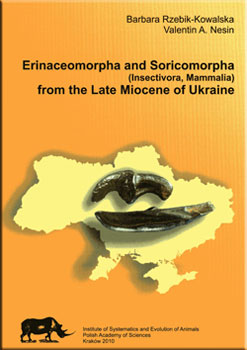
61 pp, paperback, ISBN 978-83-61358-32-9
Price: Europe 8 €
This publication presents remains of Erinaceidae, Talpidae and Soricidae found in four Late Miocene Localities of Ukraine. The remains are described, measured and illustrated, and their systematic positions and distributions are discussed. Two hedgehog taxa, nine to ten moles and ten to 13 shrew taxa were identified. Erinaceidae are represented by Schizogalerix cf. sarmaticus and cf. Postpalerinaceus sp., Desmanella cf. dubia, Desmanella sp., Ruemkelia sp., Desmana cf. nehringi, Desmaninae gen. et sp. indeterminata 1 and 2, Urotrichus giganteus, ?Scaptonyx sp., Talpa gilothi, and Desmanodon major represent the Talpidae. The Soricidae include ?Miosorex sp., Crusafontina kormosi, Amblycoptus oligodon, Amblycoptus sp. or Kordosia sp., ?Petenyia sp., Petenyia cf. dubia, Mafia cf. dehneli, ?Neomysorex cf. alpinoides, Asoriculus cf. gibberodon, Asoriculus sp., Sorex pseudoalpinus, Zelceina cf. podlesicensis and "Paenelimnoecus" repenningi.
Ewa Krzemińska, Wiesław Krzemiński & Christine Dahl (2009)
Monograph of fossil Trichoceridae (Diptera): Over 180 million years of evolution
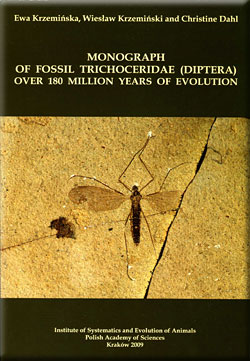
171 pp, paperback, ISBN 978-83-61358-20-6
Price: Europe 20 €
The monograph presents complete record of fossil Trichoceridae in systematic order and the inferred phylogeny of the family based on fossil and recent taxa. The specimens come from 28 localities of Asia, Europe and North America, covering the period from the Lower Jurassic to the Upper Miocene. The higher taxonomy applied to fossil specimens is based on characters of the legs, thoracic pleura, wings and genitalia of male and female, i.e., same structures on which the taxonomy of the recent Trichoceridae is founded. The morphological structures are presented in 225 plates of photographs and drawings. Photos of nearly all specimens are included in the annex. One new subfamily, five new genera and 54 new fossil species of Trichoceridae are described and all taxa known are revised. A phylogenetic tree of the family in the chronological context is proposed. The results of our study show the radiation of the Trichoceridae in the Jurassic and change of trichoceriid fauna about the early Cretaceous.
Barbara Rzebik-Kowalska (2009)
Biodiversity of Polish fossil insectivores (Erinaceomorpha, Soricomorpha, Insectivora, Mammalia) compared to the European and global faunas
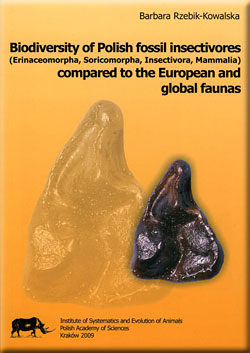
123 pp, paperback, ISBN 978-83-61358-16-9
Price: Europe 15 €
Book presents up to date information on the Miocene, Pliocene and Quaternary insectivore mammals (Erinaceomorpha and Soricomorpha) of Poland, compared against a background of European and global insectivore faunas. The fossil taxa found in Poland, taxa first described from Poland, and the localities in which insectivores have been found with lists of taxa from each are given. The history of insectivores is reviewed.
Adam Nadachowski, Marcin Żarski, Mikołaj Urbanowski, Piotr Wojtal, Barbara Miękina, Grzegorz Lipecki, Katarzyna Ochman, Mirosław Krawczyk, Gwidon Jakubowski & Teresa Tomek (2009)
Late Pleistocene environment of the Częstochowa Upland (Poland) reconstructed on the basis of faunistic evidence from archaeological cave sites
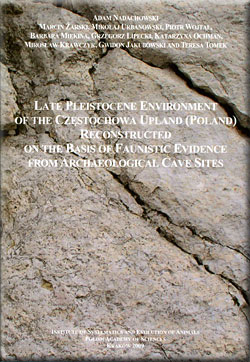
112 pp, hardback, ISBN 978-83-61358-12-1
Price: Europe 25 €
The study of Late Pleistocene environment is based on analyses of fossil vertebrate assemblages from three archaeological cave localities (Komarowa, Deszczowa and Krucza Skała). Faunistic evidence in conjunction with lithological studies and AMS 14C dating enables to reconstruct pelaeoenvironments in the studied area during almost whole late middle and late Pleistocene. The composition of faunal assemblages is described for younger Saalian (Warta Glaciation, OIS 6), Early Weichselian (Toruń Stadial and Gniew Interstadial, OIS 5d-5a), Pleni-Weichselian (Grudziądz Interstadial, OIS 3) as well as last Glacial Maximum and Late Glacial (OIS 2). Remains of Allactaga and Macaca are described from Komarowa Cave for the first time in Poland.
Zdzisława T. Stebnicka (2009)
Aphodiinae of Australia (Coleoptera: Scarabaeidae). Iconography

187 pp, hardback, ISBN 978-83-61358-24-4
Price: Europe 30 €
The fauna of Australian Aphodiinae (Coleoptera, Scarabaeidae) includes eight tribes and 30 genera with 183 known species inhabiting the Australian continent and offshore islands. Of the total number of 183 species, the 172 species are presented in iconography. The essential diagnoses of the tribes with keys to genera, descriptions of the genera and species with their synonymy, data on affinities, location of the name-bearing types, known habitats and seasonality and distribution are associated with colour photographs of beetles and drawings of the pertinent morphological details. The literature includes monographs, revisions and other publications dealing with taxonomy of the tribes on the world basis.
Teresa Tomek & Zbigniew M. Bocheński (2009)
A key for the identification of domestic bird bones in Europe: Galliformes and Columbiformes
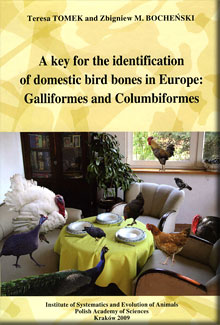
111 pp, hardback, ISBN: 978-83-61358-08-4
Price: Europe 30 €
Distinguishing between wild and domestic bird remains as well as species-specific identification of the latter is of vital importance for the correct analysis of bone remains. This book provides a dichotomous key to the identification of bones of domesticated bird species, distinguishing them from bones of all other wild species nesting, wintering or migrating in Europe. This is the second volume resulting from a project devoted to the identification of domestic bird bones. The first volume (BOCHEŃSKI & TOMEK, 2009) is intended as a general identification of bones of taxa that include domestic species (Anseriformes, Galliformes and Columbiformes).
This volume includes two parts that allow the identification to species within Galliformes and Columbiformes, respectively.
This is the first key allowing for identification of each of the two articular ends of long bones separately. All other keys deal with complete bones, which often makes it difficult to identify a broken bone. All groups containing domesticated species are thoroughly illustrated. Life-size bones of all species are shown in photographs arranged in plates. To facilitate identification work a CD containing all plates is included.
Zbigniew M. Bocheński & Teresa Tomek (2009)
A key for the identification of domestic bird bones in Europe: preliminary determination
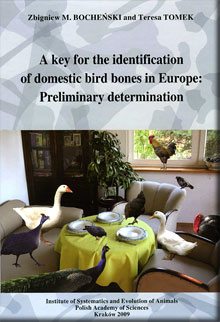
101 pp, hardback, ISBN: 978-83-61358-04-6
Price: Europe 30 €
Distinguishing between wild and domestic bird remains as well as species-specific identification of the latter is of vital importance for the correct analysis of bone remains. This book provides a dichotomous key to the identification of bones of domesticated bird species, distinguishing them from bones of all other wild species nesting, wintering or migrating in Europe. This project consists of two manuals. The first, this volume, is intended as a general identification of taxa that include domestic species (Anseriformes, Galliformes and Columbiformes).
The other volume (TOMEK & BOCHEŃSKI, 2009) includes two parts that allow the identification to species within Galliformes and Columbiformes, respectively. This is the first key allowing for identification of each of the two articular ends of long bones separately. All other keys deal with complete bones, which often makes it difficult to identify a broken bone. All groups containing domesticated species are thoroughly illustrated. Life-size bones of all species are shown in photographs arranged in plates. To facilitate identification work a CD containing all plates is included.
Zdzisława T. Stebnicka (2008)
The tribe Eupariini of New World (Coleoptera: Scarabaeidae: Aphodiinae). Iconography II
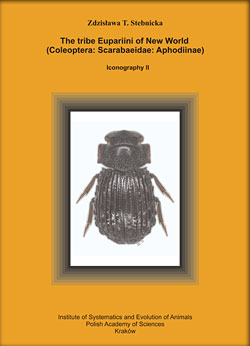
135 pp, hardback, ISBN 978-83-61358-00-8
Price: Europe 30 €
The second part of iconography of the New World Eupariini (Coleoptera, Scarabaeidae, Aphodiinae) presents 26 genera with 138 known species inhabiting American continent and West Indies. The essential diagnoses of genera and species with their known and new synonymy, affinities, bionomy and distribution are associated with colour photographs, drawings of the male genitalia and of other morphological details. The literature includes revisions, monographs and all publications on taxonomy and biology of the tribe on the world basis.
Waldemar Celary (2007)
Zagrożenia i ochrona bioróżnorodności polskich pszczół spójnicowatych (Hymenoptera: Apoidea: Anthophila: Melittidae)
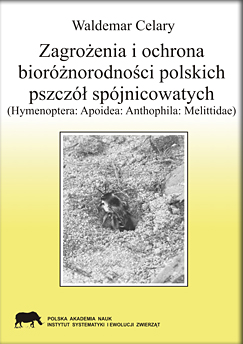
86 pp, paperback, ISBN 978-83-919407-7-8
Książka przedstawia morfologię i bionomię krajowych przedstawicieli pszczół spójnicowatych. Pokazuje także zróżnicowanie i liczebność rodzimej fauny Melittidae. Ponadto, analizuje zmiany w rozmieszczeniu poszczególnych gatunków na obszarze Polski jakie nastąpiły w ciągu ostatnich 130 lat. Na końcu przedstawia zagrożenia jakim podlegają pszczoły spójnicowate i prezentuje metody ich ochrony.
Zdzisława T. Stebnicka (2007)
The genus Ataenius Harold, 1867 (Coleoptera: Scarabaeidae) of New World. Iconography
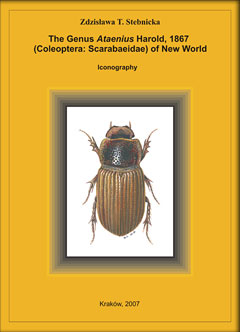
155 pp, hardback, ISBN 978-83-919407-8-5
Price: Europe 30 €
The book presents 190 known species of the genus Ataenius HAROLD, 1867, inhabiting American continent and adjacent archipelagos. The essential diagnoses of species inluding their known and new synonymy, affinities, bionomy and distribution are associated with 26 plates of colour pictures and 12 plates of greyscale drawings of the male genitalia and other morphological details. The literature includes revisions, monographs and all publications on taxonomy and biology of the genus.
Piotr Wojtal (2007)
Zooarchaeological studies of the Late Pleistocene sites in Poland
189 pp, hardback, ISBN: 978-83-919407-6-1
Price: Europe 30 €
The book’s detailed zooarchaeological descriptions of Polish sites, from the least known to the most widely known such as Kraków Spadzista Street. This study of faunal assemblages in Polish archaeological sites is an important reference for researchers who wish to learn the most up-to-date interpretations of Palaeolithic human economic relationships with animals. A central contribution made by this book is a discussion of the places of different species in human subsistence and technology, such as cave bear, reindeer, and woolly mammoth. This book is well illustrated, fully referenced, and thoughtful in presentation.
See a sample chapter of this bookMałgorzata Prajer (2006)
Regulation of the clonal cycle in the Paramecium aurelia species complex
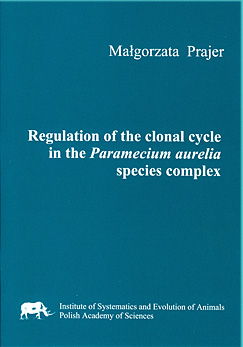
41 pages, 16 figures, paperback, ISBN 83-919407-3-X
Price: 10 €
The mechanisms of meiosis induction in Paramecium were analyzed in this publication, mainly based on the author's researches. The clonal cycle begins with fertilization preceded by meiosis. The conditionings of meiosis induction were precisely studied in cells entering autogamy, a self-fertilization process, occurring in P. aurelia species. In clones of cells, meiosis appears during starvation after passing a number of vegetative divisions (cell generations), starting from the last fertilization.
Investigations concerning the number of generations between two successive autogamies in Paramecium were performed. Genetic as well as the exogenous and endogenous factors were studied and discussed in order to elucidate their effects on induction of meiosis.
Jerzy Pawłowski i Elżbieta Warchałowska-Śliwa (2006)
Stacja biologiczna w Ojcowie
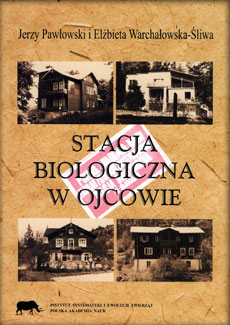
Niedawno minęło 40 lat od powołania Stacji Biologicznej Polskiej Akademii Nauk w Ojcowie. Okrągła rocznica stała się okazją do spisania historii tej placówki. Trudu tego podjęli się pierwszy Kierownik Stacji i jej organizator – profesor Jerzy Pawłowski i obecny Kierownik – docent Elżbieta Warchałowska-Śliwa.
Książka napisana jest interesującym, wartkim językiem, pełna anegdot, bogato ilustrowana zdjęciami i rysunkami pracowników, praktykantów i wielu gości odwiedzających Stację, którzy tu pracowali, odpoczywali i dobrze się bawili. Autorzy umieścili i udokumentowali wszystkie ważniejsze wydarzenia związane z historią Stacji. Dzięki temu książka stała się nie tylko zbiorem luźnych opowiadań, lecz rzetelną kroniką wydarzeń z dziejów Stacji i w pewnej mierze, naszego Instytutu oraz ludzi z nim związanych. Opracowanie to uświadamia również ważną role Stacji jako miejsca pracy polskich przyrodników prowadzących badania na terenie Ojcowskiego Parku Narodowego i jego okolic.
Oddajemy do rąk czytelnika dzieje terenowej biologicznej stacji badawczej w Ojcowie z nadzieją, że w ten sposób uchronimy od zapomnienia część historii i okoliczności badań przyrodniczych prowadzonych w okolicach Krakowa w drugiej połowie XX wieku, a także sylwetki osób związanych z tą działalnością. Wstępne części opracowania przypominają też, iż nasza Stacja kontynuowała z powodzeniem inicjatywy podjęte przez zoologów warszawskich w latach 1912-14 i naszych krakowskich poprzedników (1937-39), czemu przeszkodziły obie wojny światowe.
Waldemar Celary (2005)
Melittidae of Poland (Hymenoptera: Apoidea: Anthophila) their Biodiversity and Biology.
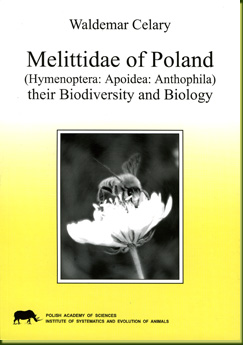
177 pp, paperback, ISBN 83-919407-1-3
Price: 25 €
A monograph of polish wild bees belonging to the family Melittidae. This book provides keys to the identification subfamilies, West Palaearctic genera and Central European species. It describes and illustrates all native species of melittid bees. It analyzes their biodiversity and abundance, summarizing and adding data on the occurrence of particular species. It contains numerous maps showing Polish localities and world distributions for each of them. The presented book describes phenology and ecology of all Polish melittid bees. It shows life cycles and behaviour of the main representatives of all melittid genera inhabiting Poland.
Zbigniew Szyndlar & Jean-Claude Rage (2003)
Non-erycine Booidea from the Oligocene and Miocene of Europe
Format: 20 x 29 cm, 111 pp, 50 figures, paperback, ISBN 83-919407-0-5
Price: 25 €
This is the first monographic description of boas, pythons, and tropidophiids inhabiting Europe in the period between the middle Oligocene and the middle Miocene. The story tells about the times when booids, in Europe and elsewhere, were absolute dominants of snake faunas as well as about the times when the domination ended and the constrictors were ousted from the European continent.
The book consists of three major parts:
I. Introductory part that provides, among others, a review of the worldwide fossil record of booid snakes.
II. Systematic part that describes or redescribes in great detail fossil remains of European Oligocene and Miocene non-erycine Booidea.
III. The final part that discusses in detail all main events of the history of the European Booidea (including Erycinae), beginning in the period around the “Grande Coupure” at the Eocene / Oligocene boundary and ending with the extinction of last boas and pythons in the middle Miocene.
The discussion considers non-booid snakes, as well. The text is supplemented throughout by numerous illustrations, mostly full-page plates, and includes an extensive bibliography.
See a sample chapter from this bookTeresa Tomek & Zbigniew M. Bocheński (2000)
The comparative osteology of European Corvids (Aves: Corvidae), with a key to the identification of their skeletal elements
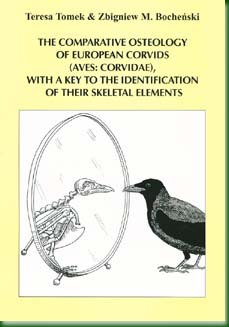
DIN A4, 102 pages, paperback, ISBN 83-907187-8-2
This book provides a comprehensive and comparative guide to the identification of skeletal elements of corvids. The study is based on 662 skeletal specimens representing 11 species of European corvids (Garrulus glandarius, Perisoreus infaustus, Pica pica, Cyanopica cyanus, Nucifraga caryocatactes, Pyrrhocorax pyrrhocorax, P. graculus, Corvus monedula, C. frugilegus, C. corone, C. corax). All major skeletal elements are included. For each species, the information is presented in a structured user-friendly format allowing easy cross reference and comparison between the various species. The book consists of two major parts: (i) practical part that can be used to identify bony remains of corvids found in contemporary, archaeological and paleontological materials, and (ii) theoretical part including systematical comments and conclusions.
This book will be considered the definitive reference work on the osteology of European corvids. It will be essential for students and researchers working in palaeontology, archaeozoology, contemporary food remains of owls and other raptors, systematics and comparative osteology.
Key features:
- A total of 110 morphological characters differentiating the species of European corvids are illustrated in separate drawings
- Basic statistics of measurements taken from each skeletal element and each species are given in appropriate tables. Seven species with sufficient number of sexed specimens examined have been checked for the sex dimorphism in size
- Chosen proportions, comparing two measurements each, are illustrated on diagrams to make easier the identification of corvid remains
- Discriminant function analyses performed for each skeletal element and each species may help identify a corvid bone to the species level











